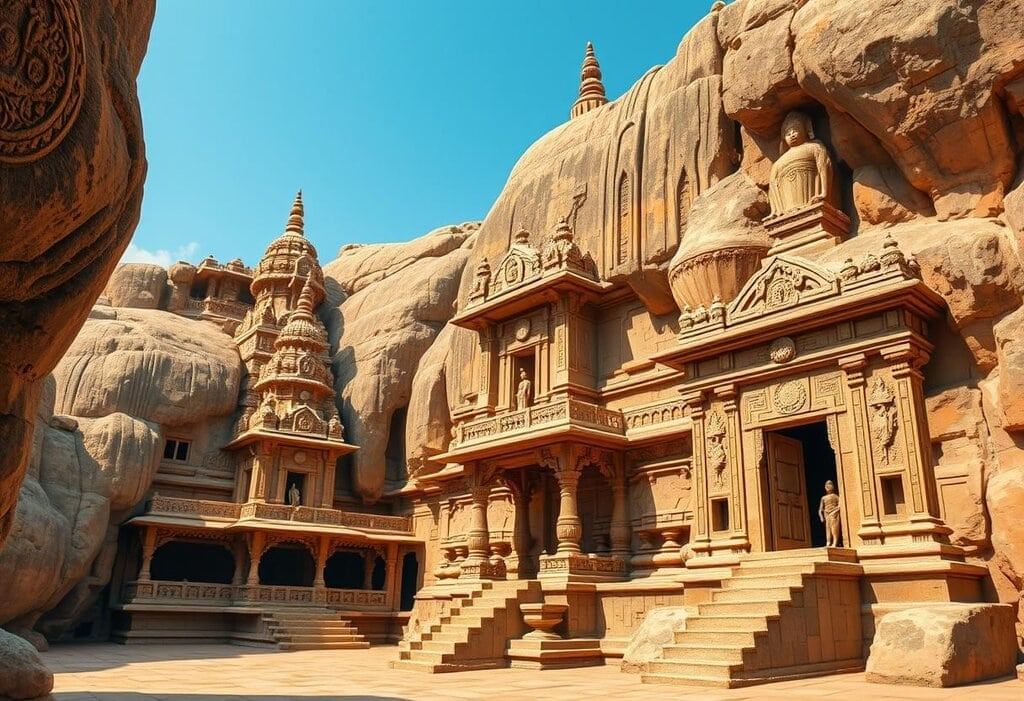UPSC Exam > UPSC Notes > History for UPSC CSE > GS1 PYQ (Mains Answer Writing): Rock Cut Architecture
GS1 PYQ (Mains Answer Writing): Rock Cut Architecture | History for UPSC CSE PDF Download
The rock-cut architecture represents one of the most important sources of our knowledge of early Indian art and history. Discuss. (GS 1 Mains Paper)
 Buddhist rock-cut templesRock cut architecture occupies a central place in Indian architecture. It gives information about life and times of people and helps us understand their society through their perspective.Rock cut Architecture as source of knowledge
Buddhist rock-cut templesRock cut architecture occupies a central place in Indian architecture. It gives information about life and times of people and helps us understand their society through their perspective.Rock cut Architecture as source of knowledge
- Rock-cut caves belonging to the third century BCE have been found in different parts of India. It shows the popularity of Yaksha worship and how it became part of figure representation in Buddhist and Jaina religious monuments.
- Depiction of a monumental rock-cut elephant at Dhauli in Odisha gives us information about the social and religious trends in the era. It has Ashokan rock-edict. All these examples are remarkable
- in their execution of figure representation. The rock-cut cave carved at Barabar hills near Gaya in Bihar is known as the Lomus Rishi cave. It was donated by Ashoka for the Ajivika sect and Buddhist and Jain monks as places of worship and residence.
- The Ajanta Caves in Maharashtra, a World Heritage Site, constitute thirty rock-cut cave Buddhist temples carved; murals here are recognized as some of the greatest art produced by humankind.
- There are stories from Jataka, depiction of Buddhist legends and divinities. This gives an insight into the socio political scenario in ancient India.
- Kailash temple at Ellora built by the Rashtrakutas and the Ratha temples of Mahabalipuram built by the Pallavas are other examples of rock-cut temples.
- The earliest cave temples include the Bhaja Caves, the Karla Caves, the Bedse Caves, the Kanheri Caves, and some of the Ajanta Caves. Relics found in these caves suggest a connection between the religious and the commercial. Buddhist missionaries are known to have accompanied traders on the busy international trading routes through India.
- Kanheri caves acted as education center in Western India. Water resources are prevalent at Kanheri which shows water harvesting was practiced at caves
Conclusion
Thus it can be seen that rock cut architecture helps us to trace the life in India and its evolution through socio political perspective.
Topics covered - The Mauryan empire, The South Indian Kingdoms, Buddhism & Jainism
The document GS1 PYQ (Mains Answer Writing): Rock Cut Architecture | History for UPSC CSE is a part of the UPSC Course History for UPSC CSE.
All you need of UPSC at this link: UPSC
|
110 videos|652 docs|168 tests
|
FAQs on GS1 PYQ (Mains Answer Writing): Rock Cut Architecture - History for UPSC CSE
| 1. What is rock-cut architecture? |  |
Ans. Rock-cut architecture refers to the practice of creating structures by carving into natural rock formations, such as caves, cliffs, or mountains.
| 2. What are some famous examples of rock-cut architecture around the world? |  |
Ans. Some famous examples of rock-cut architecture include the Ajanta and Ellora Caves in India, Petra in Jordan, and the rock-cut churches of Lalibela in Ethiopia.
| 3. What are the advantages of rock-cut architecture? |  |
Ans. Rock-cut architecture is known for its durability, as structures carved into solid rock are less susceptible to natural disasters such as earthquakes. Additionally, rock-cut buildings provide natural insulation and are often cooler in hot climates.
| 4. How was rock-cut architecture practiced in ancient civilizations? |  |
Ans. In ancient civilizations, rock-cut architecture was primarily carried out using simple tools such as chisels, hammers, and drills. Skilled artisans would carefully carve into the rock to create intricate structures.
| 5. What cultural significance does rock-cut architecture hold? |  |
Ans. Rock-cut architecture often reflects the religious and cultural beliefs of the civilizations that created them. These structures serve as important historical and archaeological sites, offering insights into ancient societies and their architectural techniques.
Related Searches

















